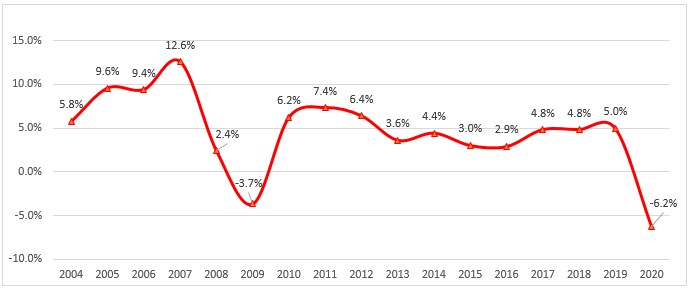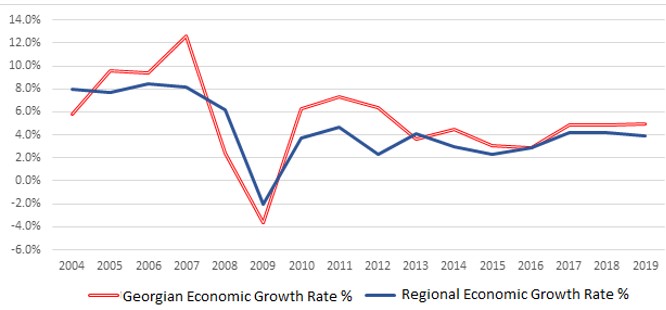Roman Gotsiridze: “For eight years, the average annual economic growth was 2.75% and without the pandemic year it would be 3.9%. The economic growth rate was twice as fast during those nine years [under the United National Movement’s rule].”
Verdict: FactCheck concludes that Roman Gotsiridze’s statement is MOSTLY TRUE.
Resume:
In 2013-2020, the economy was growing by 2.81% on average under the Georgian Dream’s rule whilst the average annual economic growth was 6.24% in 2004-2012 under the United National Movement’s rule. Therefore, the economy was growing 2.2 times faster in 2004-2012 as compared to 2013-2020. The annual economic growth in 2013-2019; that is, not counting the pandemic year 2020, was 4.09%. In 2004-2012, not counting 2009, the average annual economic growth was 7.48% and it would be 8.2% without both 2008 and 2009. Therefore, Roman Gotsiridze’s figures are moreless correct.
Since the context of the statement is explicitly critical towards the incumbent government, it would be relevant to compare Georgia’s economic development dynamic to those of the regional countries because Georgia is an open economy and both internal and external factors affect its economic conjuncture. For comparison, it is appropriate to use the World Bank’s Eastern Europe and Central Asia Region which includes 22 other countries with Georgia. In 2004-2012, the average annual economic growth in the region was 5.3% and it slowed down to 3.5% in 2013-2019. Therefore, Georgia’s economic growth rate was still higher in 2013-2019 as compared to the regional growth rate. Among Georgia’s immediate neighbour countries, the average annual economic growth rate was 7.6% in 2003-2012 and it dropped to 3% in 2013-2019 which naturally also had its effect on Georgia.
Analysis:
United National Movement member, Roman Gotsiridze, stated: “For eight years, the annual average economic growth was 2.75%. In 2013-2019, without the pandemic year, the economic growth rate was 3.9%. In those nine years, Georgia’s economic growth rate was nearly 2.3 times higher as compared to the economic growth under the incumbent government. If we exclude the similar crisis from the equation, economic growth in 2004-2012 would be twice as much.”
The gross domestic product is the total value of all finished goods and services produced within a country’s borders in one year. The GDP growth is measured by changes in the real GDP shown in base year prices which excludes the inflation effect on growth. Additionally, it has to be clarified that the National Statistics Office of Georgia released new GDP figures as a result of the adoption a new methodology of the Systems of National Account which made Georgia’s GDP figures higher. The GDP growth is different in different years. The GDP figures since 2010 have been subject to revision and the GDP figures for 2003-2012 are calculated by the old methodology which is a valid source to assess the GDP dynamic.
In 2013-2020, the economy was growing by 2.81% on average under the Georgian Dream’s rule whilst the average annual economic growth was 6.24% in 2004-2012 under the United National Movement’s rule. Therefore, the economy was growing 2.2 times faster in 2004-2012 as compared to 2013-2020. The annual economic growth in 2013-2019; that is, not counting the pandemic year 2020, was 4.09%. In 2004-2012, not counting 2009 (the world economic crisis), the average annual economic growth was 7.48% and it would be 8.2% without both 2008 and 2009. Therefore, Roman Gotsiridze’s figures are moreless correct.
Graph 1: Georgia’s Economic Growth Rate, 2004-2008 (%)

Source: National Statistics Office of Georgia
Of note is that a comparison of crises is conditional and their impact on the economy is naturally different in scale. In addition, Georgia is an open economy and both internal and external factors affect its economic conjuncture. For comparison, it is appropriate to use the World Bank’s Eastern Europe and Central Asia Region which includes 22 other countries with Georgia. In 2004-2012, the average annual economic growth in the region was 5.3% and it slowed down to 3.5% in 2013-2019. Therefore, Georgia’s economic growth rate was higher in 2013-2019 as compared to the regional growth rate. Among Georgia’s immediate neighbour countries, the average annual economic growth rate was 7.6% in 2003-2012 and it more than halved to 3% in 2013-2019 which naturally also had its effect on Georgia.
Graph 2: Economic Growth Rate in Georgia and the Region, 2004-20019

Source: International Monetary Fund

![“For eight years, the average annual economic growth was 2.75% and without the pandemic year it would be 3.9%. The economic growth rate was twice as fast during those nine years [under the United National Movement’s rule].”](https://www.factcheck.ge/storage/files/320x180/dfa12480-c1c3-11ea-a80c-83fa08fc2841.jpg)






